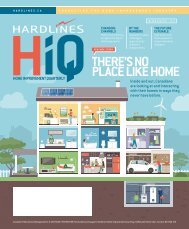T O P 2 O
Create successful ePaper yourself
Turn your PDF publications into a flip-book with our unique Google optimized e-Paper software.
EXECUTIVE INTERVIEW<br />
TERRY DAVIS<br />
“We really want to make sure the Home Hardware brand is<br />
well represented in the market and we’ve made the decision with<br />
some dealers that they are not the right fit for us.”<br />
DIVERSIFICATION IS ONE ANSWER<br />
In many of the communities where the Home brand is popular,<br />
one of the trends, says Davis, has been consolidation of the<br />
Home Hardware and Home Hardware Building Centre formats.<br />
It’s part of a larger trend by dealers to move into more building<br />
materials. As a traditional hardware store looks to add more<br />
products, expansion into a home centre format suits many of<br />
them. The same trend is occurring among its traditional lumber<br />
yards, as Home Building Centres are growing into full-line<br />
Home Hardware Building Centres. For some dealers already<br />
selling LBM, décor showrooms are becoming the answer. “We’re<br />
definitely seeing more design centres. They’re just taking off<br />
like gangbusters.”<br />
If a dealer wants to expand their lines in, say, flooring, tiling,<br />
carpeting, or doors and windows, a design centre becomes a good<br />
way to expand the existing business. Sometimes it can be done<br />
right in the existing store, but more and more design centres are<br />
popping up as stand-alone outlets.<br />
Home’s only spin-off banner, Home Furniture, is another way<br />
dealers can grow their existing business. With its focus on big-ticket<br />
heavy goods, the furniture business can become either a standalone<br />
store or an extension of an existing store, typically with its own<br />
entrance, a more subdued ambience, and its own sales team.<br />
AT ITS ROOTS IN HARDWARE<br />
The roots of Home Hardware remain its hardware dealers, even as<br />
that store format goes through changes of its own.<br />
Terry Davis explains<br />
that when a dealer puts<br />
up a Home Hardware<br />
sign it becomes easier<br />
to start selling a wider<br />
range of products.<br />
A BEGINNER’S<br />
GUIDE TO<br />
THE CLASH<br />
Rock and roll music in the early<br />
1970s was settling into a polished,<br />
tightly produced format that many<br />
considered “over-produced.” In the<br />
mid-’70s, a new form of music emerged that resisted<br />
this polished sound. Punk music became the anthem for the<br />
disaffected youth of a generation, and the Clash were part of<br />
that movement in the UK.<br />
Fronted by guitarist and singer Joe Strummer, The Clash<br />
were notable for their loud, fast music, with influences of<br />
reggae. The group’s third album, “London Calling,” provided the<br />
breakthrough that really opened up the band to North American<br />
audiences with the song, “London Calling.”<br />
Fans reflected the disaffected style and sentiments behind<br />
punk with an energetic form of dancing called “the pogo.” It<br />
consisted of hopping up and down in a fashion similar to a pogo<br />
stick, sometimes bouncing off other people dancing around them.<br />
The Home Hardware brand creates a certain customer expectation,<br />
says Davis. When shoppers walk into a Home Hardware<br />
store, they expect to find all the things they see in the ads and in<br />
the flyers—regardless of how small the store might be.<br />
He admits that the pure hardware format is growing less than<br />
Home’s larger home centres and building centres. The hardware<br />
store remains viable, however. In fact, those stores in the Home<br />
family outperformed the other formats last year. “Comp-store<br />
sales are strongest on the Home Hardware side. But what’s happening<br />
more and more with Home Hardware stores is they’re<br />
carrying convenience lumber because it’s part of the Home Hardware<br />
brand.”<br />
Davis explains that when a dealer puts up a Home Hardware<br />
sign it becomes easier to start selling a wider range of products,<br />
including some building materials, because that is what people<br />
expect when they go into any Home Hardware store. The result<br />
is that many of those dealers choose to expand into full-sized<br />
home centres.<br />
Regardless of the format or the size of a Home Hardware store,<br />
the focus at head office, even under its new leadership, remains<br />
clearly aimed at those dealers themselves and serving the communities<br />
in which they operate. That leadership just might be doing<br />
it a little louder and with a little more attitude now.<br />
36 THIRD QUARTER / 2014<br />
Hardlines Home Improvement Quarterly<br />
www.hardlines.ca

















